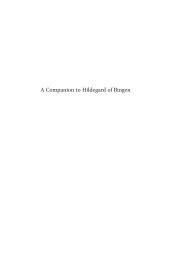Herinnering in geschrift en praktijk in religieuze gemeenschappen
Create successful ePaper yourself
Turn your PDF publications into a flip-book with our unique Google optimized e-Paper software.
and k<strong>in</strong>gs of England from Robert the Magnific<strong>en</strong>t (1028-35) to the account of the White Ship<br />
disaster <strong>in</strong> November 1120 wh<strong>en</strong> William Adel<strong>in</strong>, eldest son and heir of K<strong>in</strong>g H<strong>en</strong>ry I (1100-<br />
1135) died <strong>in</strong> the shipwreck. Special att<strong>en</strong>tion throughout is paid to the earls of War<strong>en</strong>ne and<br />
the support that they gave to the Norman k<strong>in</strong>gs of England. The largest space is devoted to the<br />
relationship betwe<strong>en</strong> William II of War<strong>en</strong>ne and K<strong>in</strong>g H<strong>en</strong>ry I. The crucial question as to how<br />
far the War<strong>en</strong>ne chronicler may have covered the years beyond 1120 is impossible to answer<br />
def<strong>in</strong>itively. The new argum<strong>en</strong>t put forward rec<strong>en</strong>tly is that the War<strong>en</strong>ne Chronicle was<br />
composed early <strong>in</strong> the reign of k<strong>in</strong>g H<strong>en</strong>ry II probably shortly after 1157, wh<strong>en</strong> William IV and<br />
his wife Isabel lost the lands giv<strong>en</strong> to them <strong>in</strong> 1153. 6 The narrative probably formed part of the<br />
appeal process and was meant to rem<strong>in</strong>d the k<strong>in</strong>g of the <strong>in</strong>valuable support his ancestors and<br />
particularly his grandfather H<strong>en</strong>ry I received from the War<strong>en</strong>nes, especially <strong>in</strong> Normandy <strong>in</strong> the<br />
years 1114-20, the period which takes up almost half of the narrative. Although the chronicle<br />
survives anonymously there are good grounds to suggest that its author may have be<strong>en</strong> Master<br />
Eustace of Boulogne, chancellor of William IV and Isabel. Other writt<strong>en</strong> sources are the<br />
family ’s charters which have be<strong>en</strong> published <strong>in</strong> volume VIII of the Early Yorkshire Charters<br />
series and form an <strong>in</strong>disp<strong>en</strong>sible collection of data which allows us to trace the ext<strong>en</strong>d of the<br />
family k<strong>in</strong> group, b<strong>en</strong>efactions to family foundations and liturgical remembrance of ancestors. 7<br />
The limitations of the War<strong>en</strong>ne Chronicle and the charters are that they provide little clues as<br />
to the material and visual aspects of the memorial traditions and their decl<strong>in</strong>e.<br />
Illustration 1 – Gundrada’s tomb stone (Southover church, near Lewes,UK)<br />
Fortunately, and exceptionally, one of the actual tombs of the War<strong>en</strong>ne family has survived.<br />
Gundrada’s tombstone, the oldest surviv<strong>in</strong>g tombstone of a woman <strong>in</strong> England, can still be se<strong>en</strong><br />
<strong>in</strong> Southover church near Brighton to where it was transported after its discovery <strong>in</strong> the former<br />
grounds of St. Pancras Lewes (Illustration 1). 8 With it go two <strong>en</strong>graved lead<strong>en</strong> mid twelfthc<strong>en</strong>tury<br />
caskets <strong>in</strong> which the rema<strong>in</strong>s of Gundrada and her husband William had be<strong>en</strong> kept<br />
s<strong>in</strong>ce their transfer to a new grave <strong>in</strong> c.1147 on the occasion of the consecration of the new<br />
abbey church at St. Pancras (Illustrations 2 and 3). While William’s tombstone (known from<br />
6<br />
Van Houts, ‘The War<strong>en</strong>ne View of the Past, 1066-1203’, 110-14.<br />
7<br />
Early Yorkshire Charters, Vol. VIII.<br />
8<br />
F. Anderson, ‘“Uxor mea”, the First Wife of William of War<strong>en</strong>ne’, Sussex Archaeological Collections, 130<br />
(1992), pp. 107-29; for a differ<strong>en</strong>t <strong>in</strong>terpretation of the epitaph, see E. van Houts, ‘The Epitaph of Gundrada of<br />
War<strong>en</strong>ne’, <strong>in</strong> Nova de Veteribus: mittel-und neulate<strong>in</strong>ische Studi<strong>en</strong> für Paul Gerhard Schmidt, ed. A. Bihrer and<br />
E. Ste<strong>in</strong> (Munich: K.G.Saur, 2004), pp. 366-78.<br />
29
















